Why we need new frameworks
In the past 40 years, there has been nothing short of an explosion of social enterprises seeking to have a positive impact on society. According to the Global Entrepreneurship Monitor (GEM) in 2015, one-third of all new ventures created around the world were done so primarily for a social or environmental purpose as opposed to a commercial aim.
But despite the growth of social enterprises, we face serious challenges in building a truly sustainable society. The World Economic Forum recently noted: “There is no future for business as usual – we are reaching irreversible tipping points for nature and climate, and over half of the global GDP, $44 trillion, is potentially threatened by nature loss.”
Why hasn’t the explosive growth in social enterprises led to a better outlook for society? One of the challenges we see is that many social enterprises focus on the “less bad” solutions or on addressing the symptoms of a problem rather than the root causes.
At Metabolic Ventures, we believe that addressing our shared societal challenges will require evolving our thinking for how we build mission-driven enterprises. For that purpose, we have been working on frameworks that help us understand what it means to build not just ventures that are helpful, but ventures that are working to transform the system they are working within to be fundamentally more regenerative by design.
Systemic Venture Framework (SVF)
What it is
Metabolic Ventures has developed the Systemic Venture Framework (SVF), which acts as a qualitative lens through which to design, support, assess, and improve ventures that aim to create transformative impact.
Having worked at the intersection of systems thinking and high-impact venture building, as well as assisting the transition of organizations in many different sectors and industries, Metabolic looked to uncover the key approaches and criteria that more transformative enterprises have in common. We also spent two years mapping out what we believe are the key initial components of an enterprise that has the long-term potential to create significant positive change.
The SVF includes 20 building blocks, and it guides entrepreneurs through key questions that should be answered to effectively construct each block. The framework can thus be used as a design tool, providing the parameters we should be aiming for when designing a transformative venture in the early stages.
Potential vs. actual impact
It is key to note that the SVF considers systemic impact potential.
Typical impact assessments that attempt to quantify actual impact do so by measuring lagging indicators. These are often quantitative, but nevertheless use direct output metrics—how much CO2 has been saved, how many jobs have been created, how many people have been trained, etc.
However, systemic impact takes a significant amount of time to prove out and can be difficult to measure, particularly for early-stage ventures. As an example, you could probably calculate Tesla’s CO2 impact, but could you quantify the effect they have had on the automobile industry? Although quantitatively measuring outcomes is also important, and we need to improve how we are able to capture the indirect — or systemic — impacts an organization is having, we cannot possibly wait 10-15 years to understand a venture’s impact on the overall system. We need early ways to assess the potential of a venture to have large-scale, systemic impacts.
Potential and qualitative impacts are not a unique way to judge a venture in the early stages. Most investors will say they look first and foremost at the team, which is both a leading indicator of success and highly qualitative. Leading, qualitative indicators are thus effective (and accessible) tools to help us make educated assumptions about a venture’s future potential.
What it includes
The SVF includes four top-level categories:
Each category has a number of criteria or sub-objectives that dive into more specifics, with 20 in total. And each of those has a number of questions that help guide entrepreneurial teams to do the thinking necessary for an intelligent and holistic design of a high-impact venture.
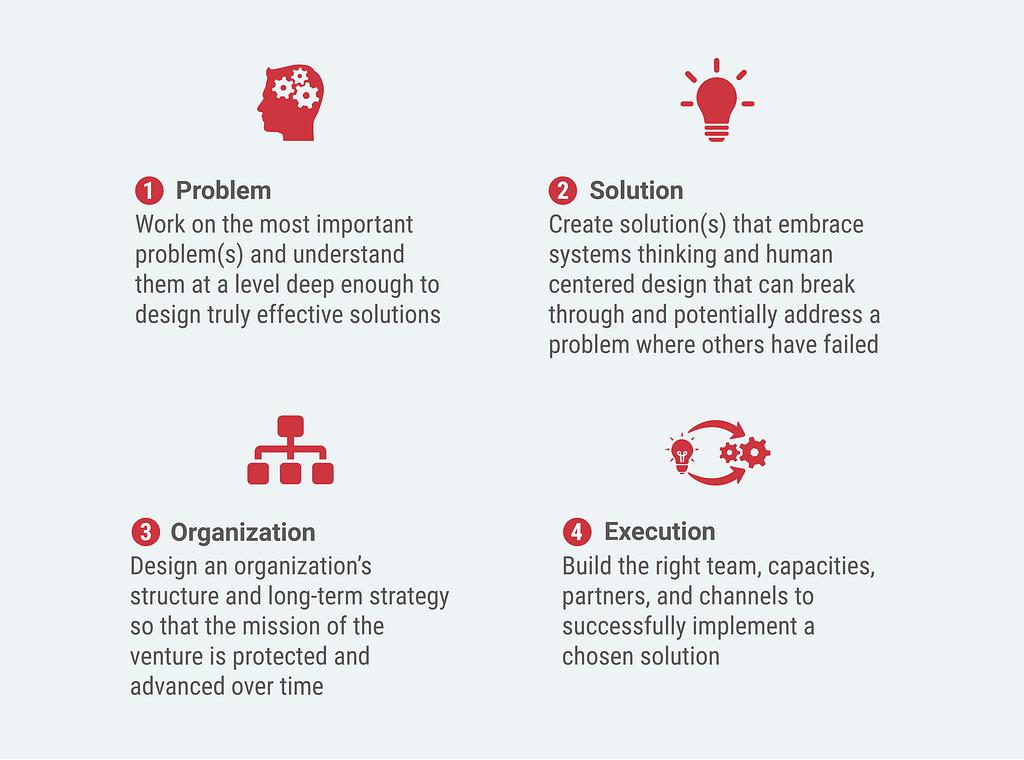
How it works
The assessment is structured in four sequential pillars based on how a venture is developed:
- Understanding the problem
- Constructing a solution around the problem
- Building an organization
- Executing on the mission
Therefore, it is important to follow the general flow of categories and questions, from 1-4. For example, it does not make sense to come up with solutions until the problem you are working to address is known and understood at a deep level.
The questions are designed as triggers to help venturers adequately construct each building block. Answering some questions may be easy, while others can take significant time and consideration. In our experience, patience pays off, and we suggest using various tools derived from design thinking, systems thinking, and enterprise design to assist in building towards fulfilling answers. Metabolic Ventures will put together tools to help entrepreneurs on this journey, but in the meantime, there are many decent resources available elsewhere.
The framework
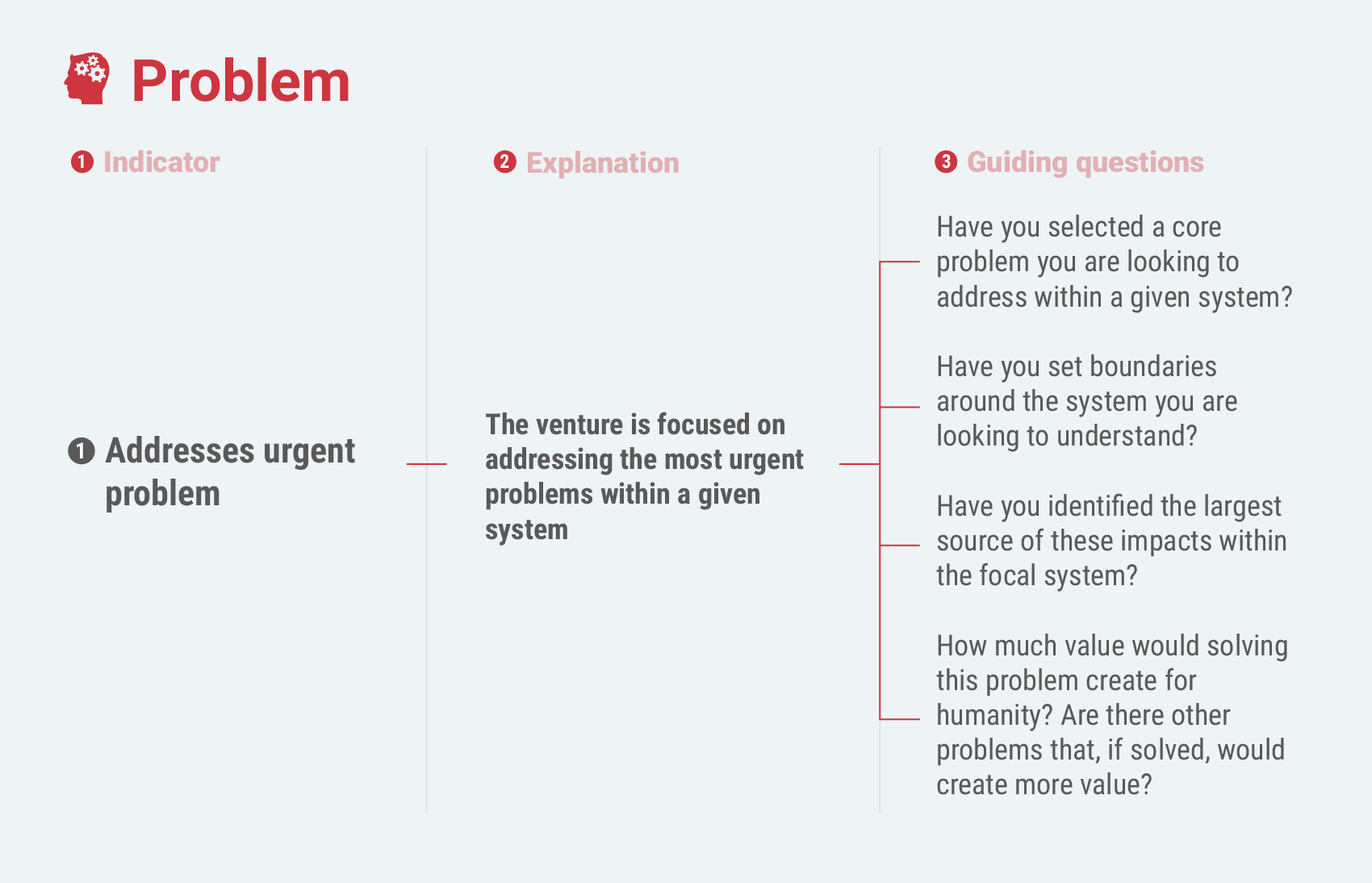
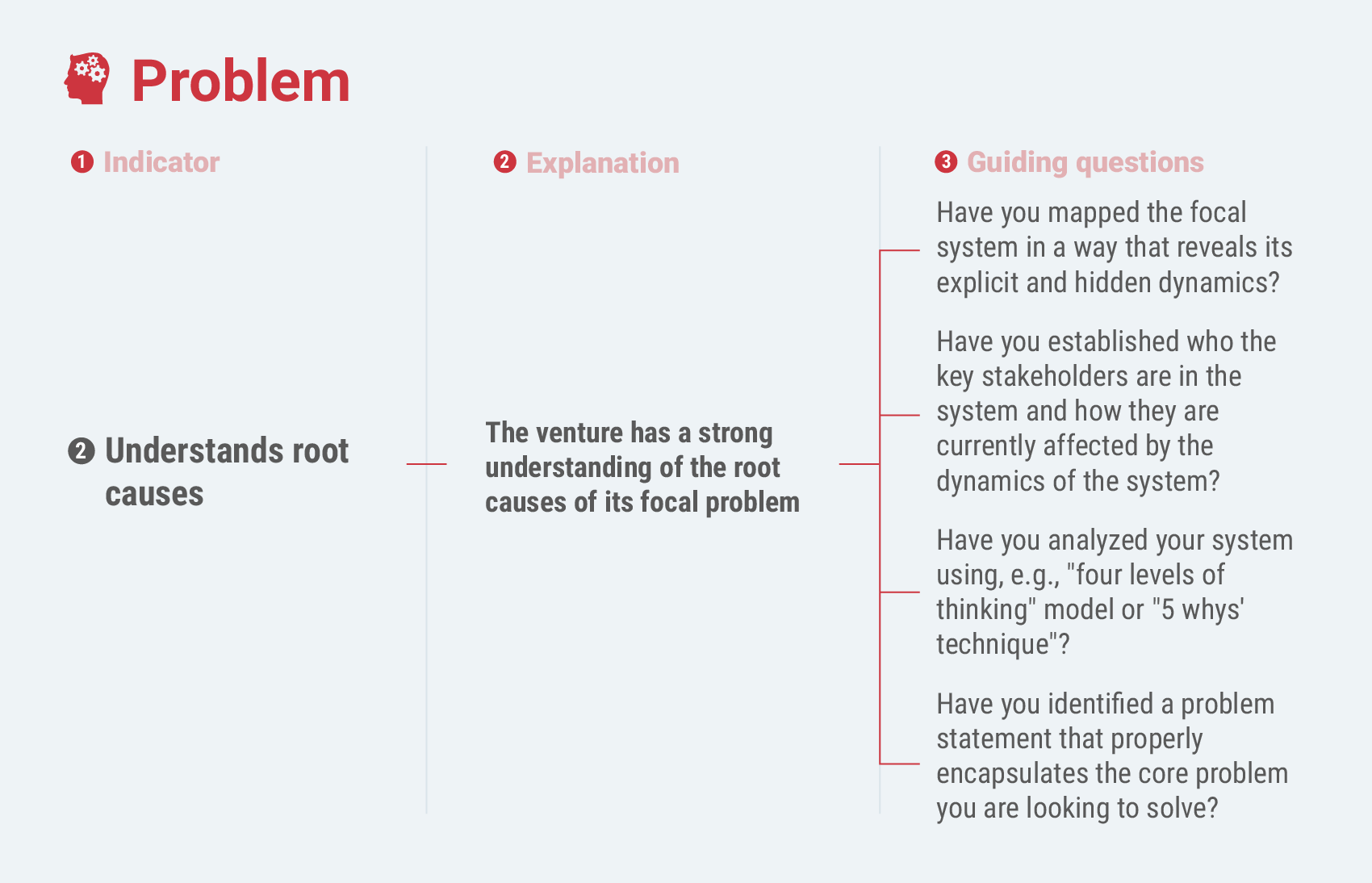
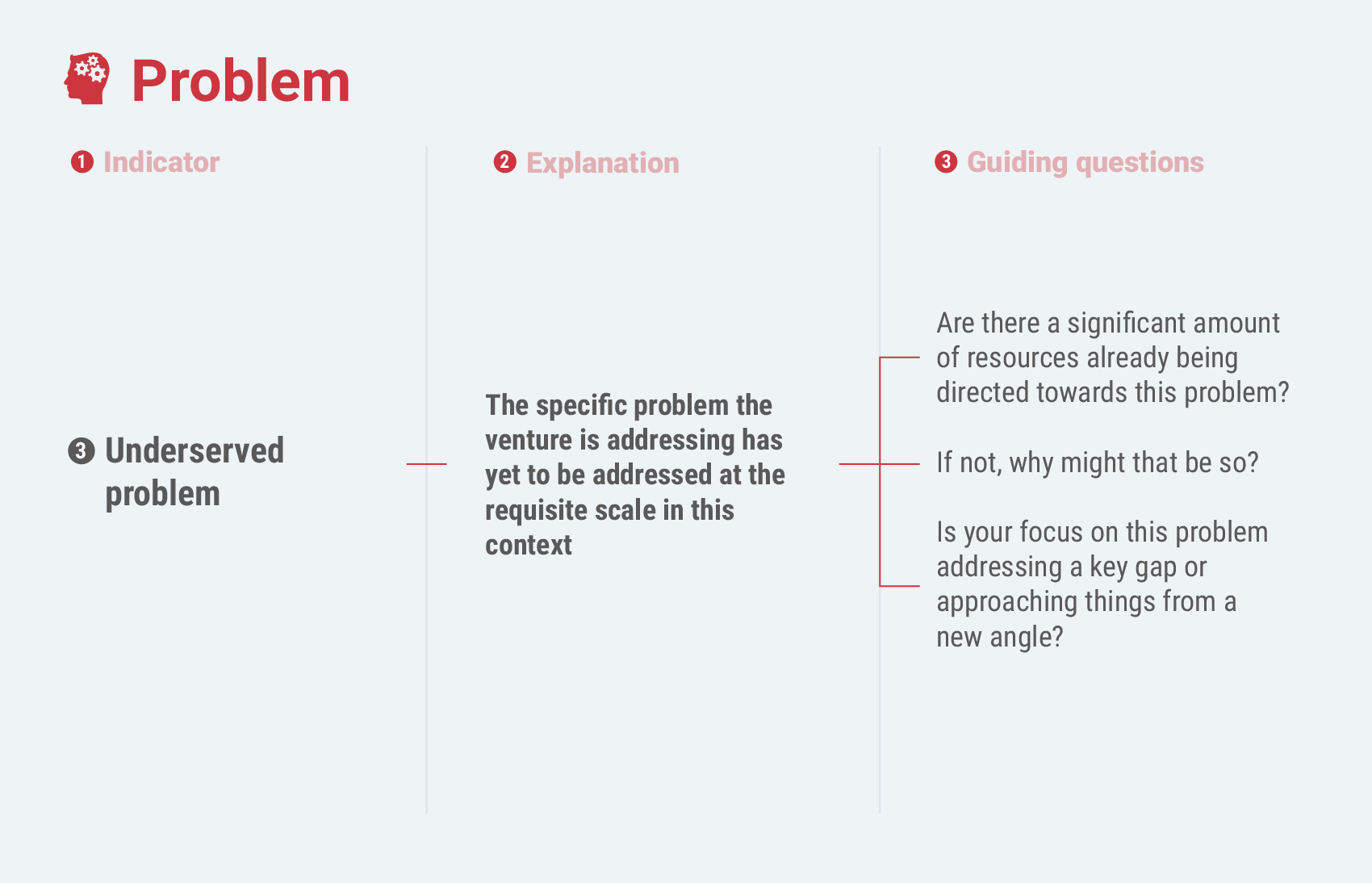
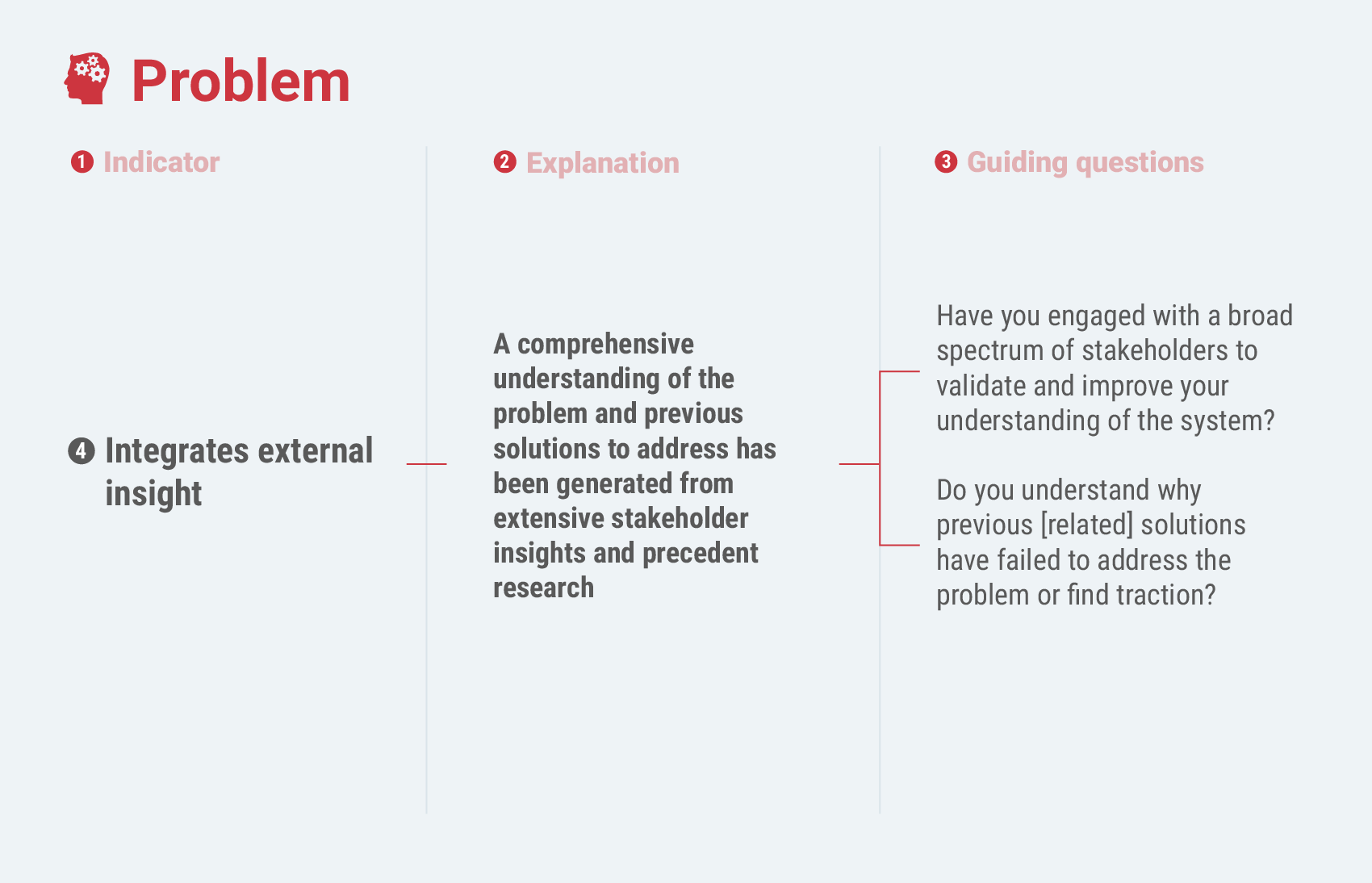
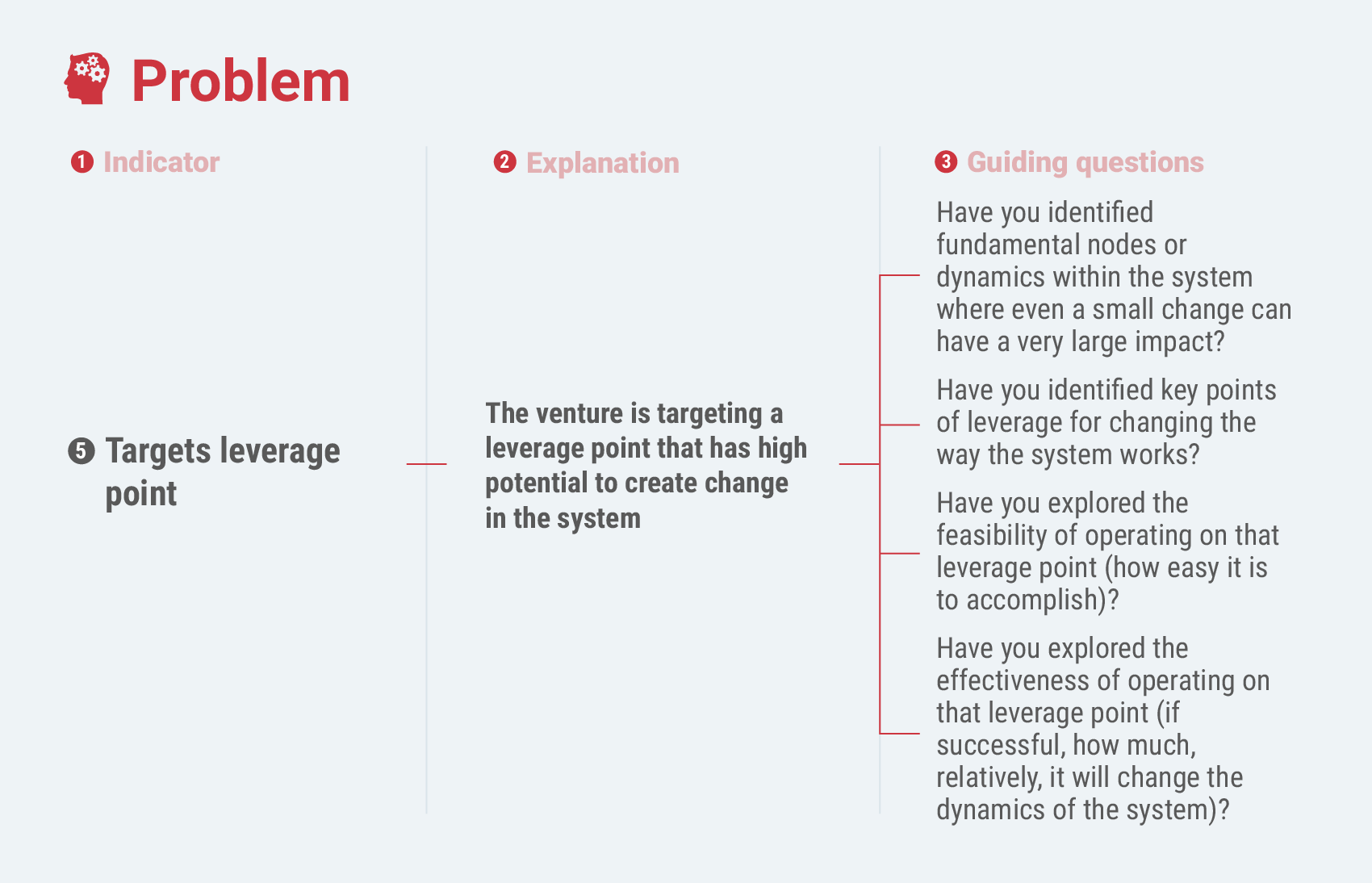

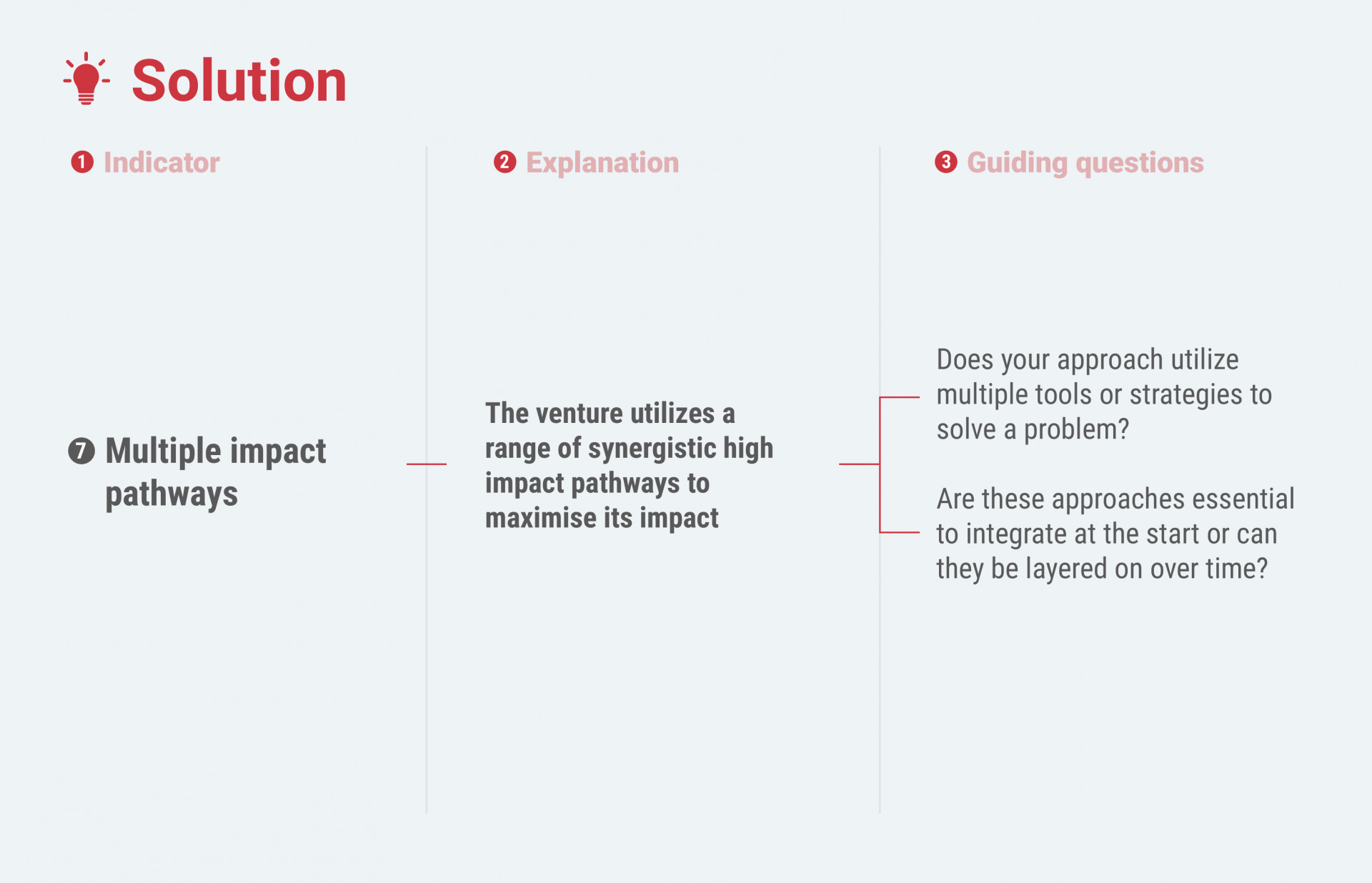
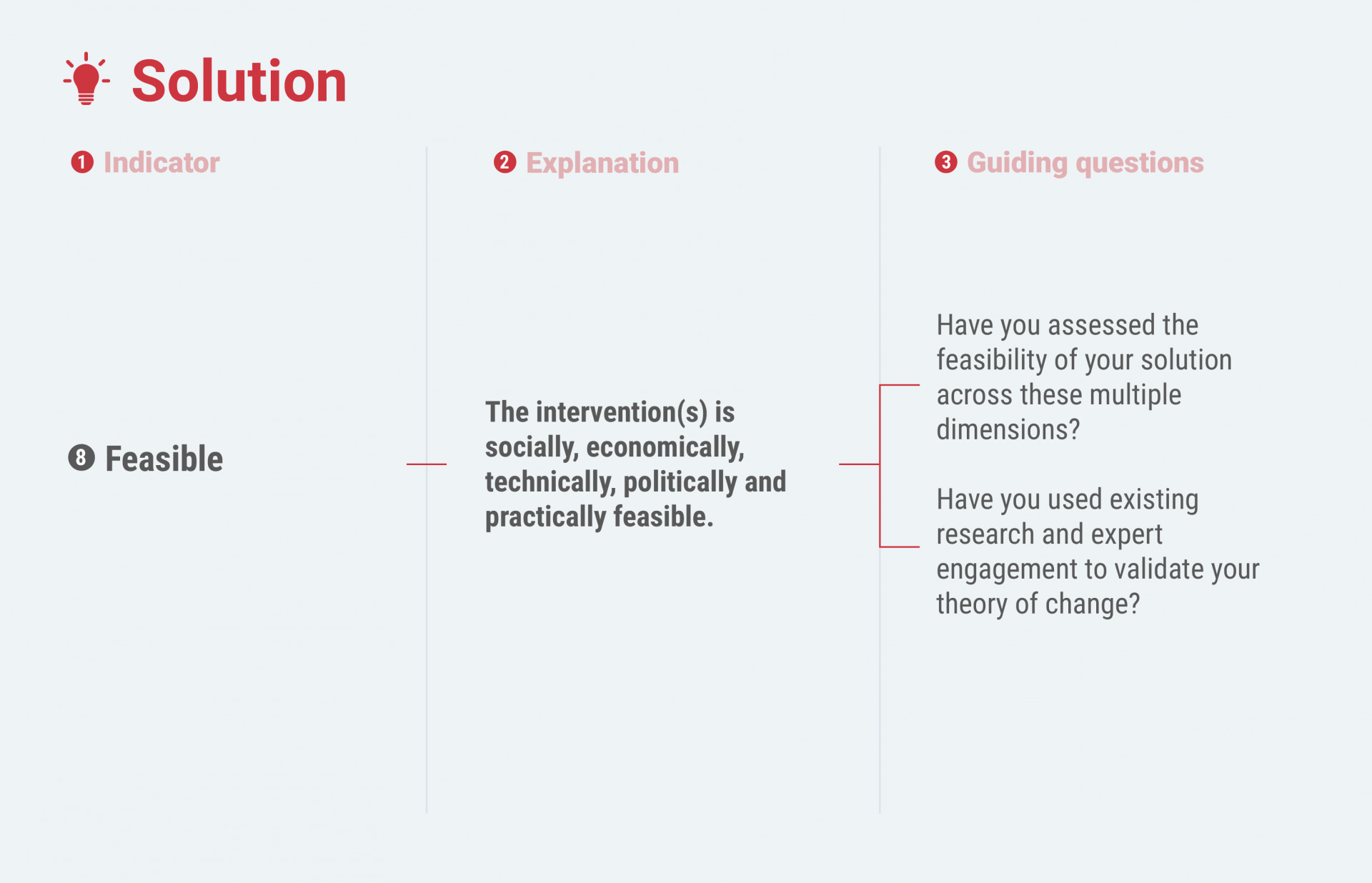
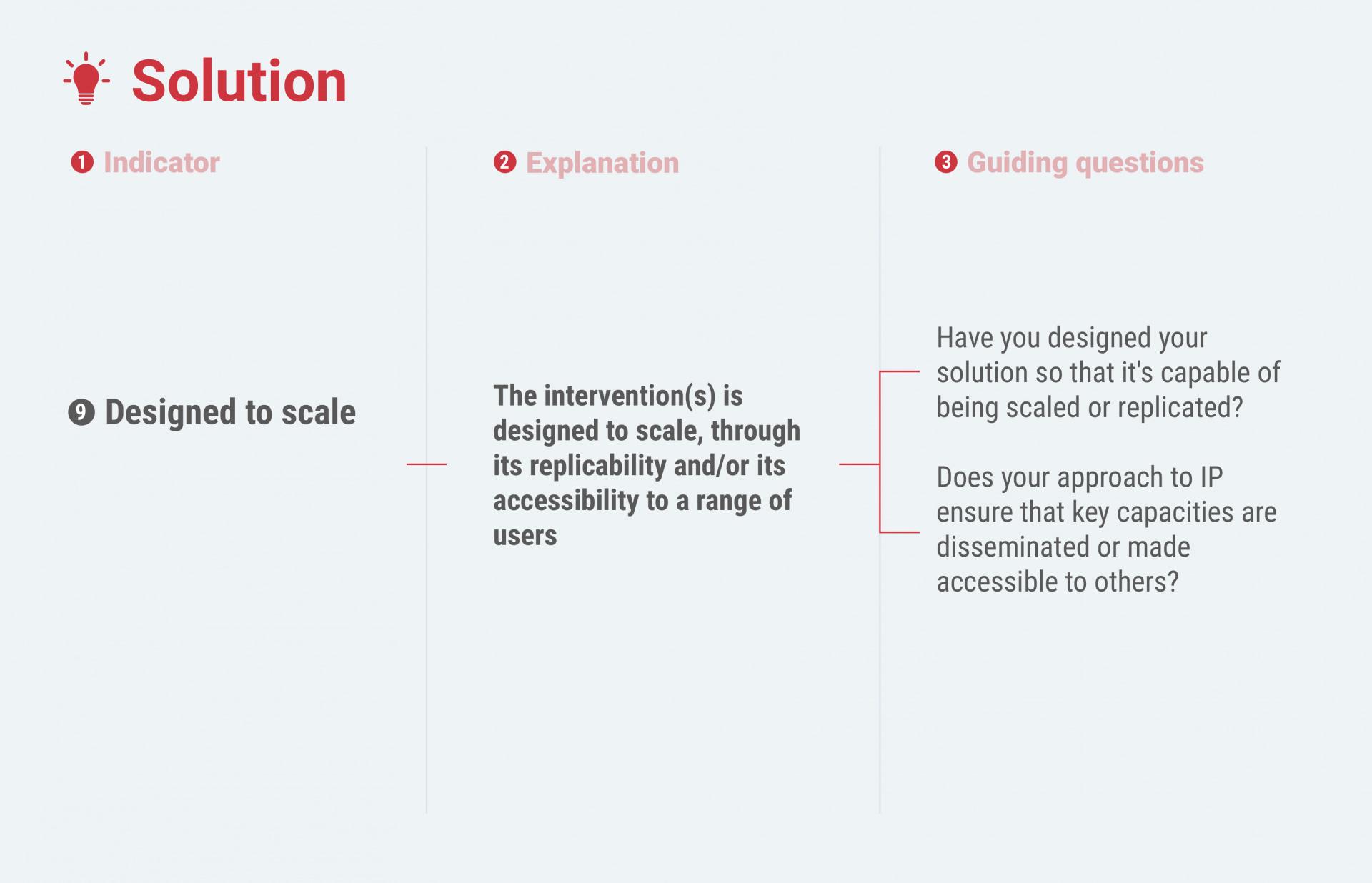
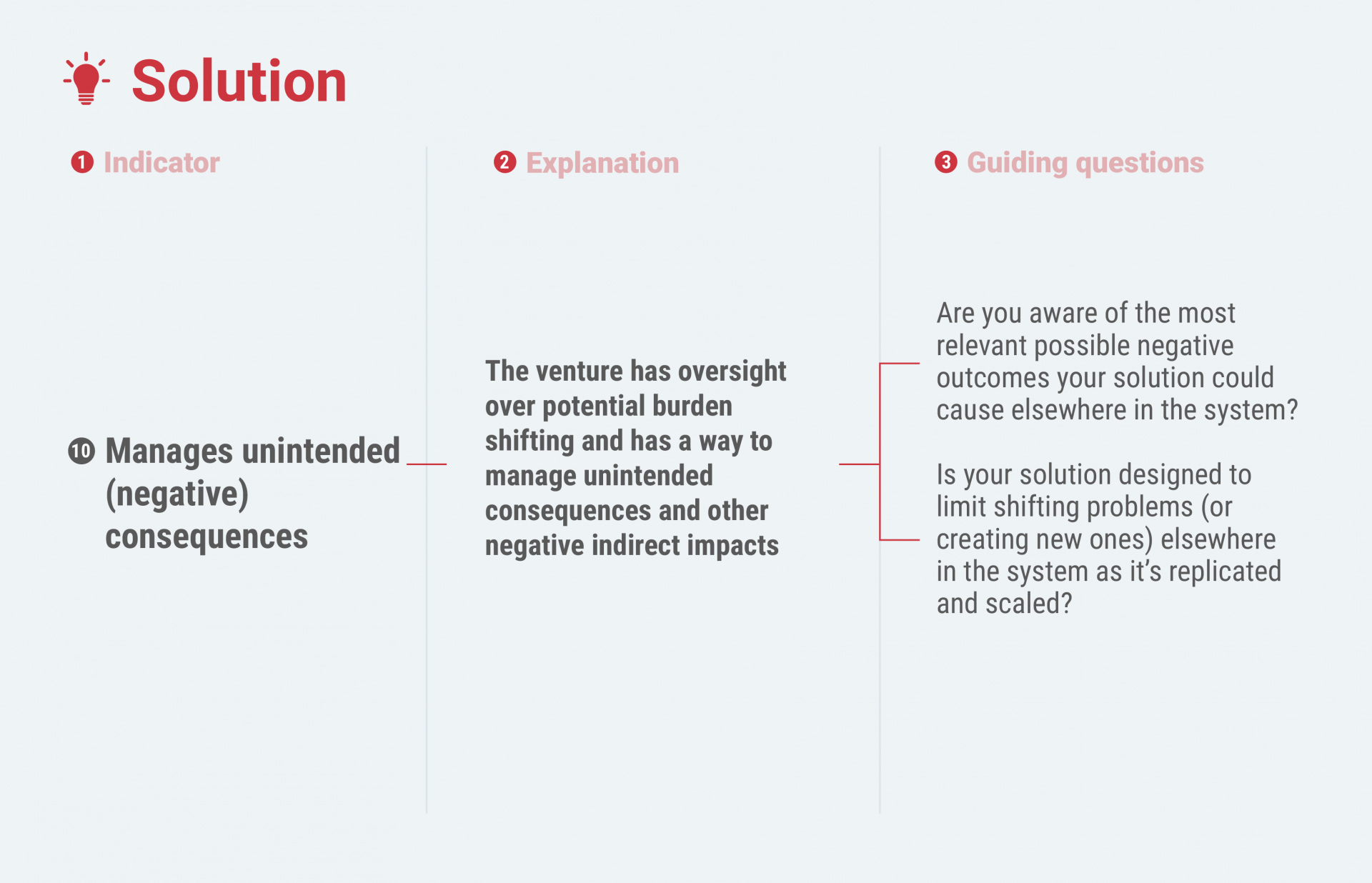
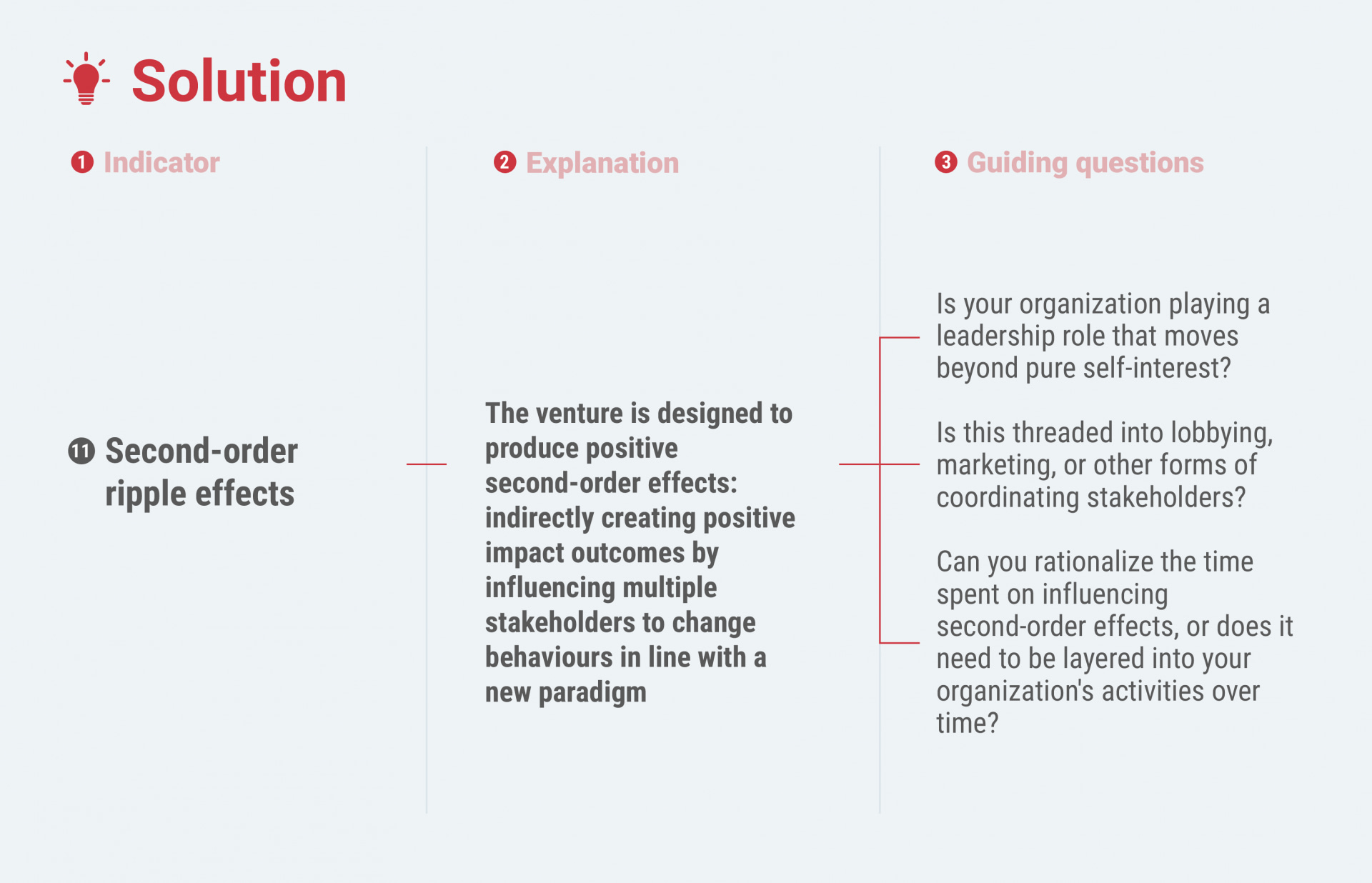
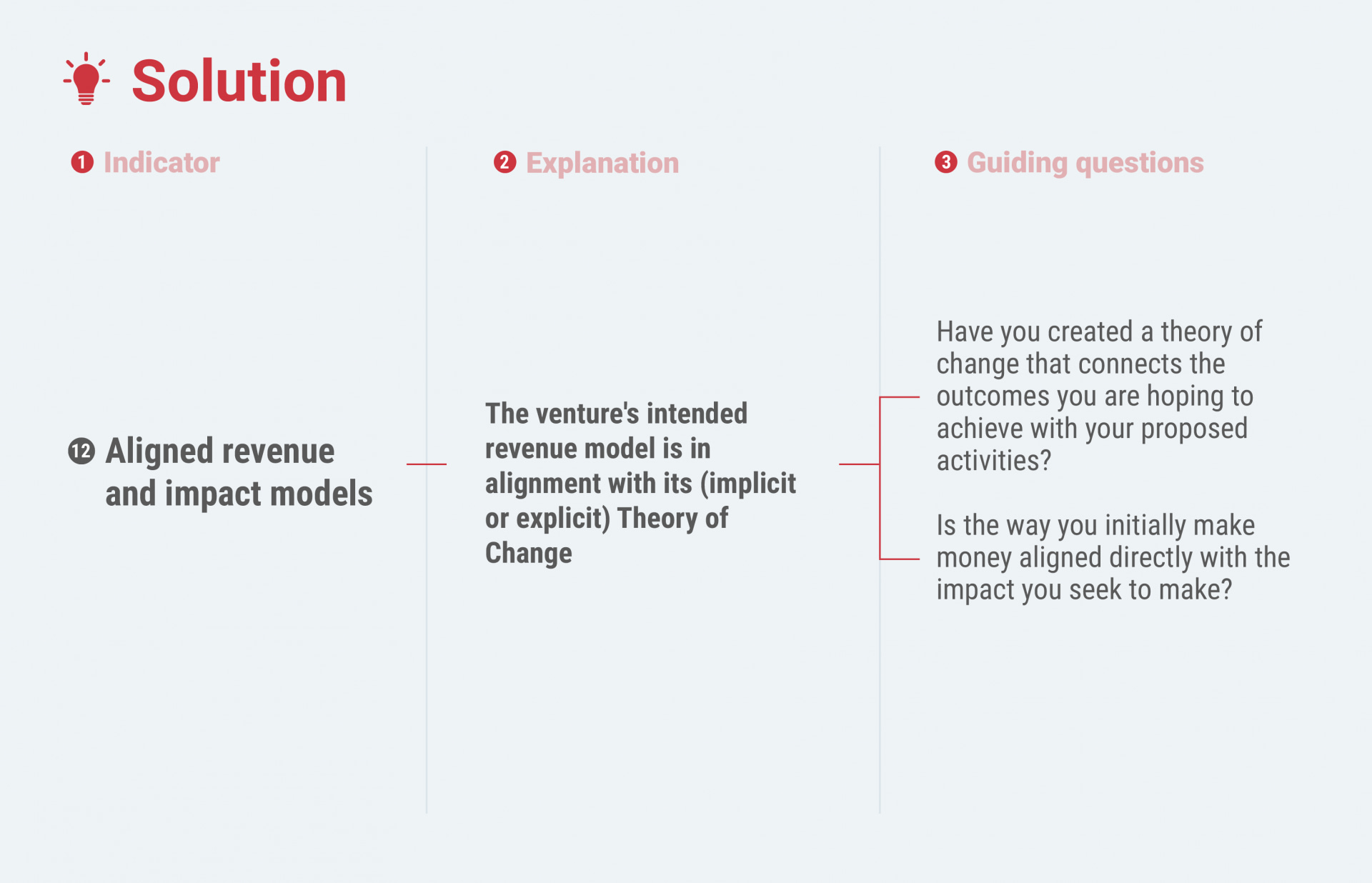
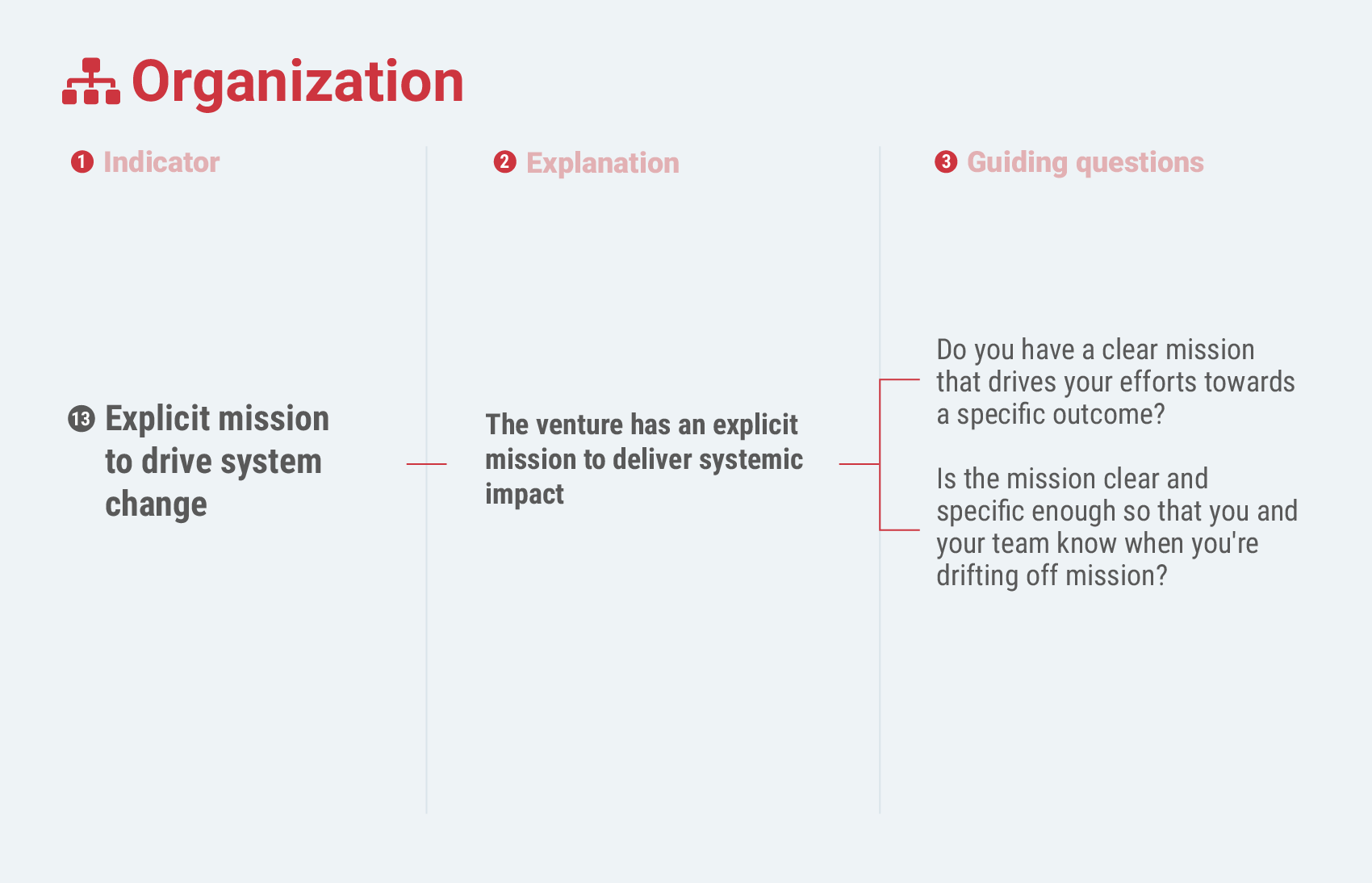
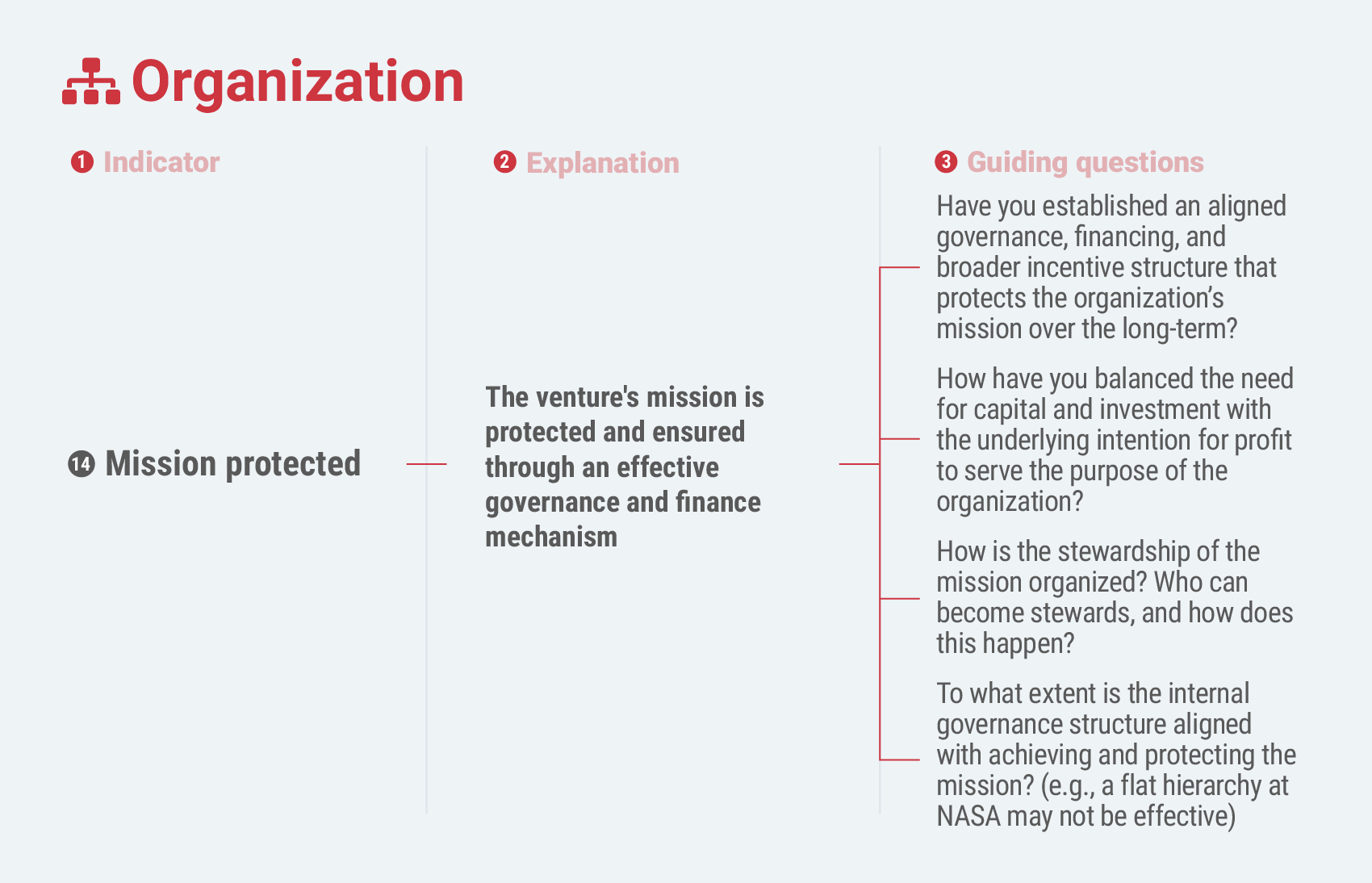
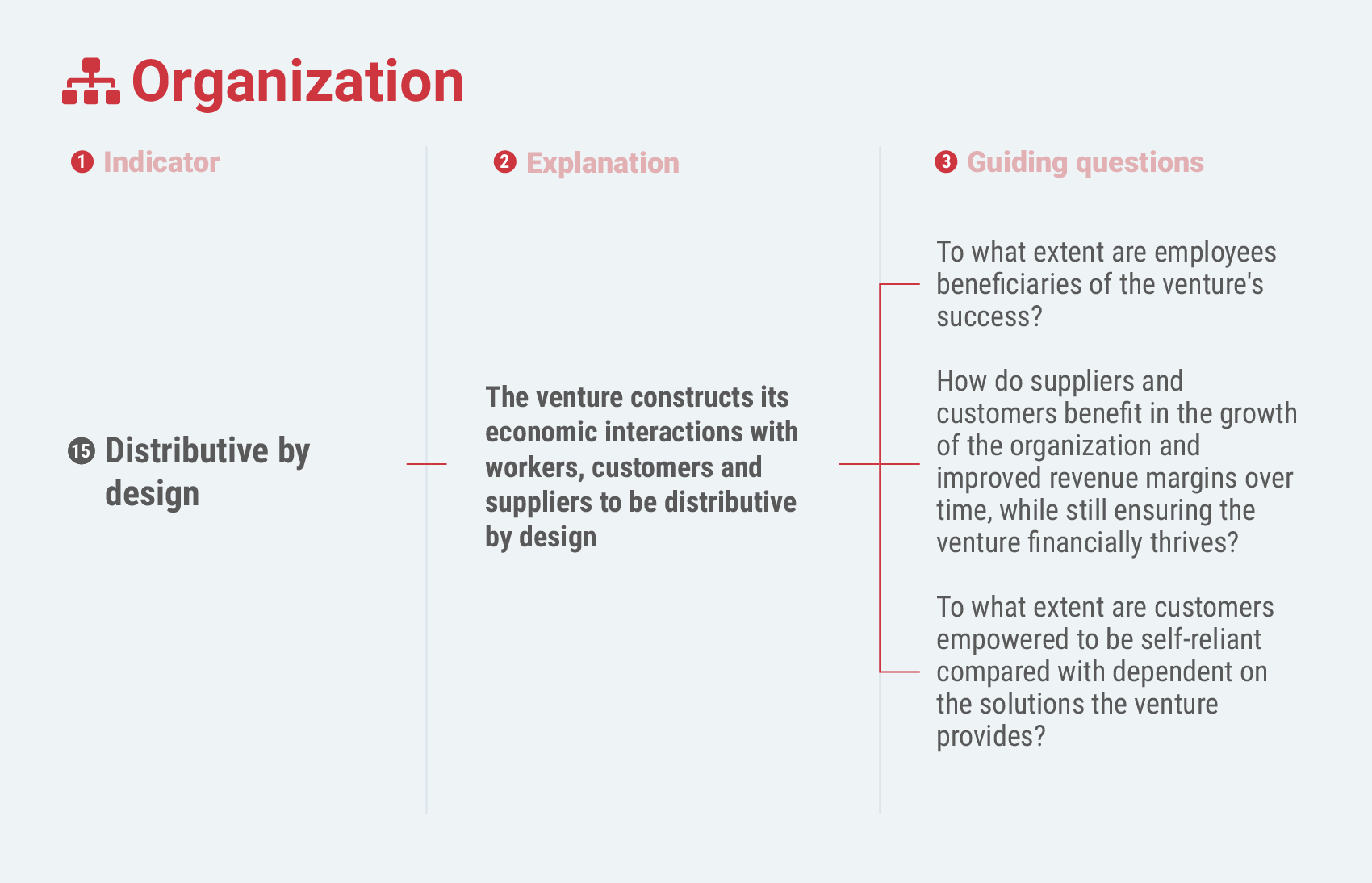
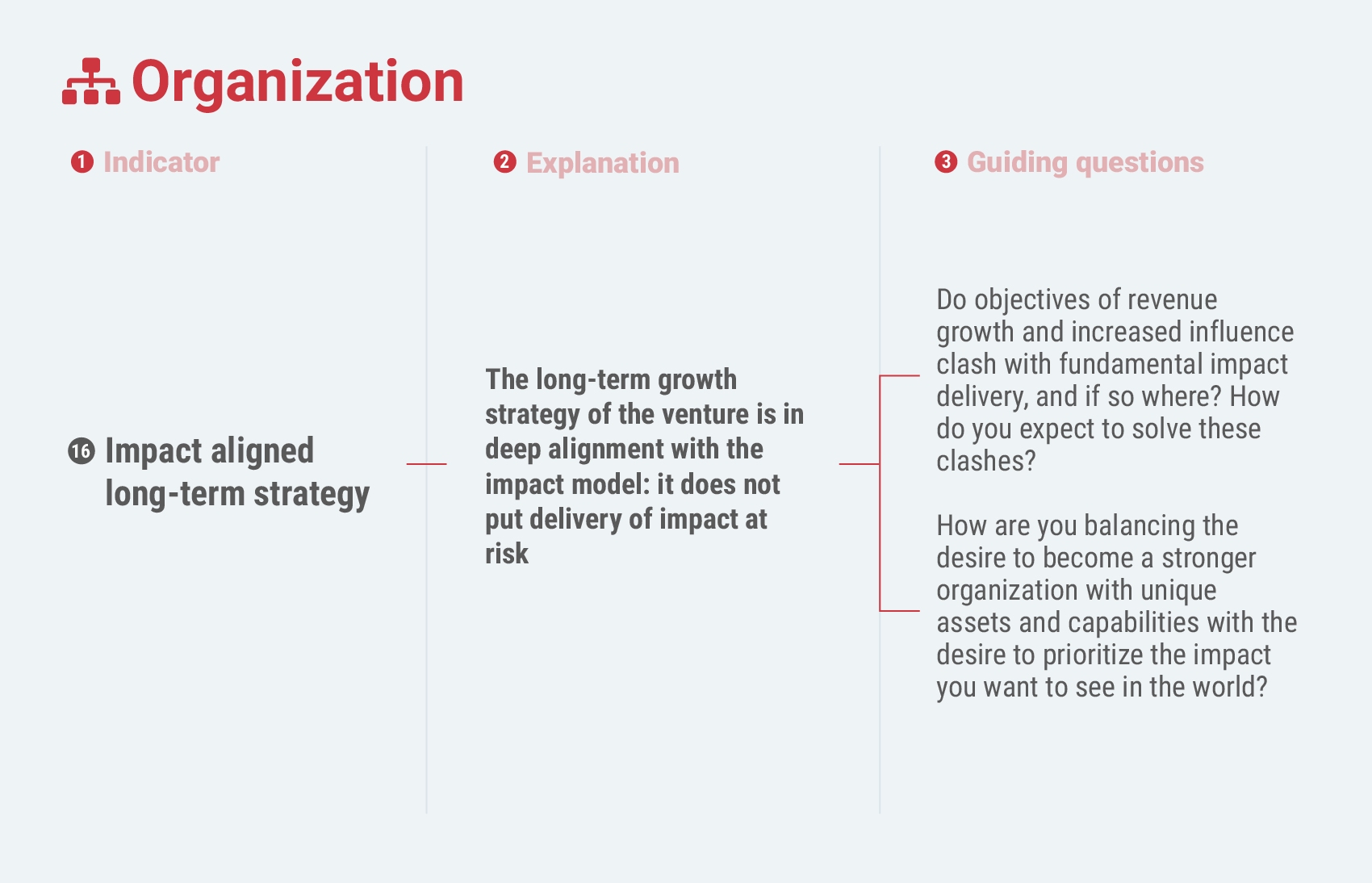
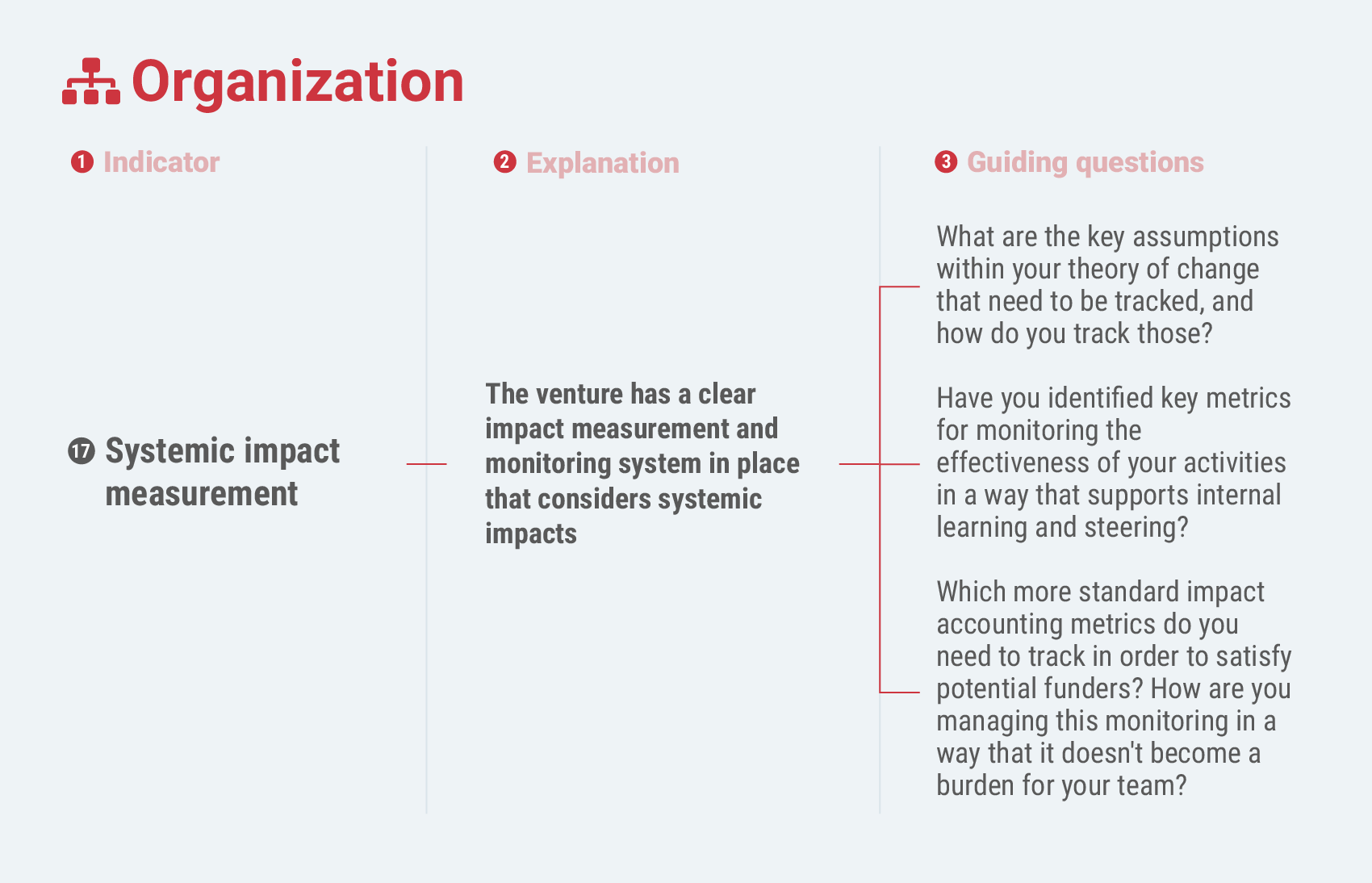
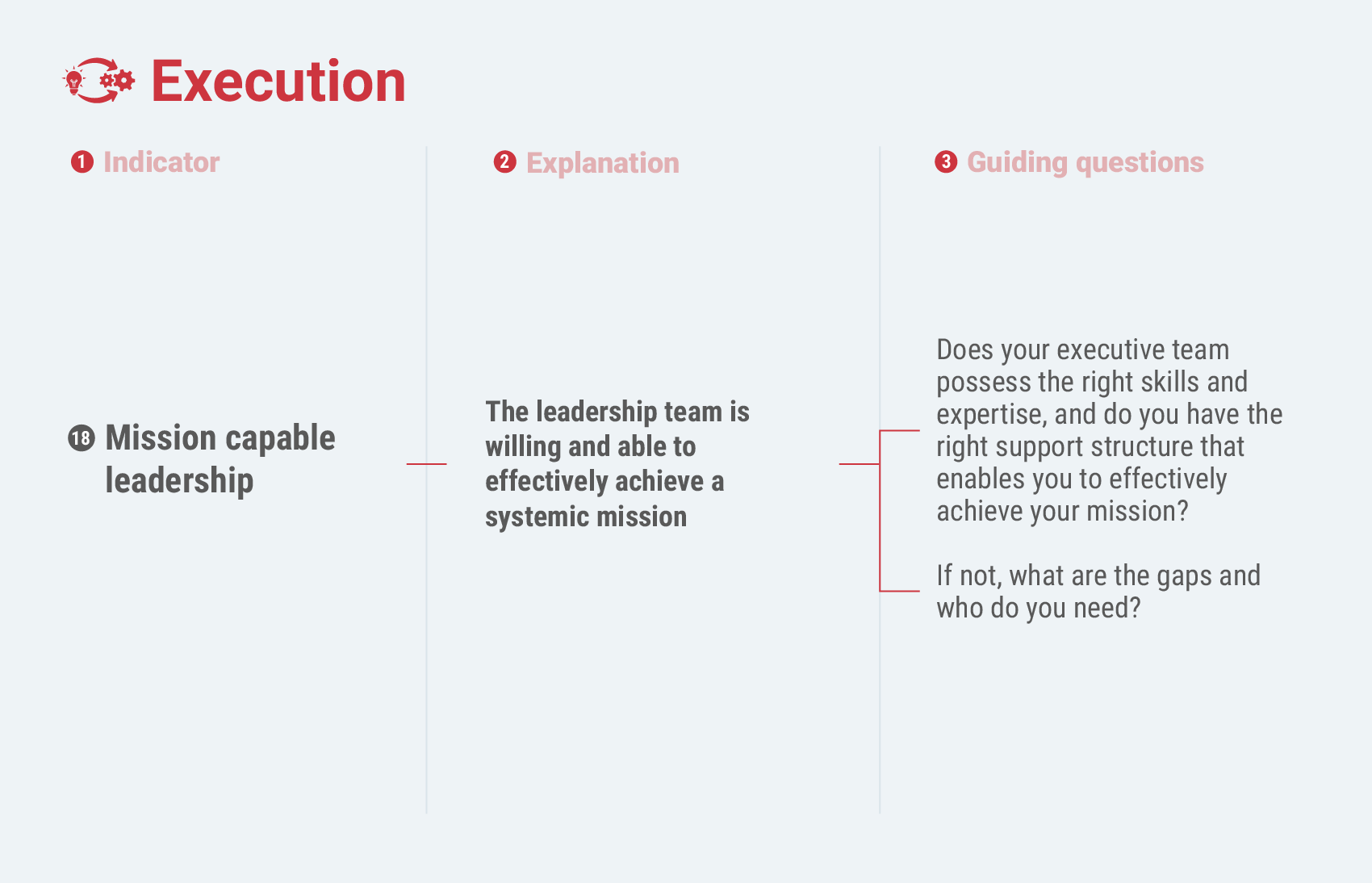
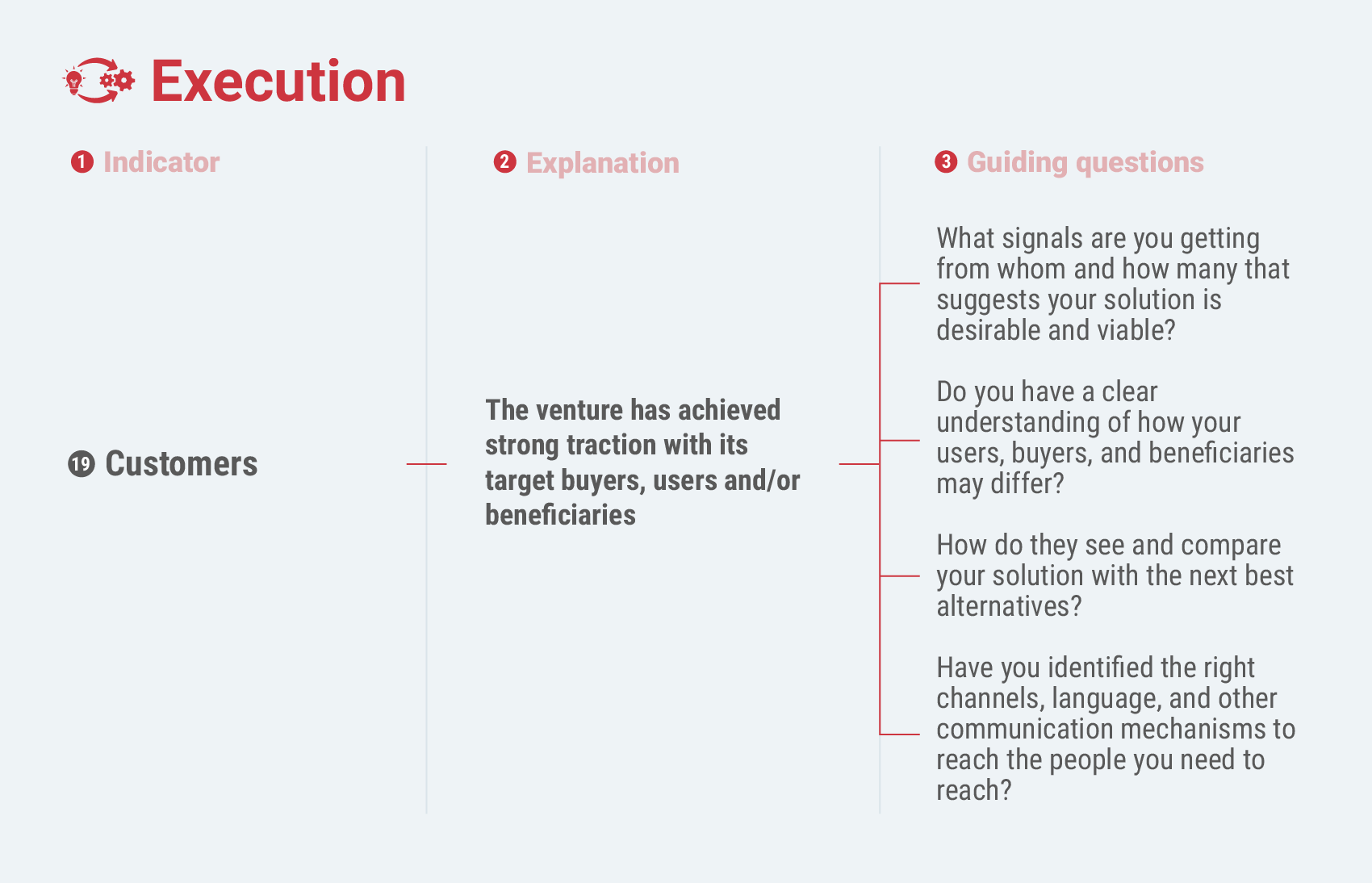
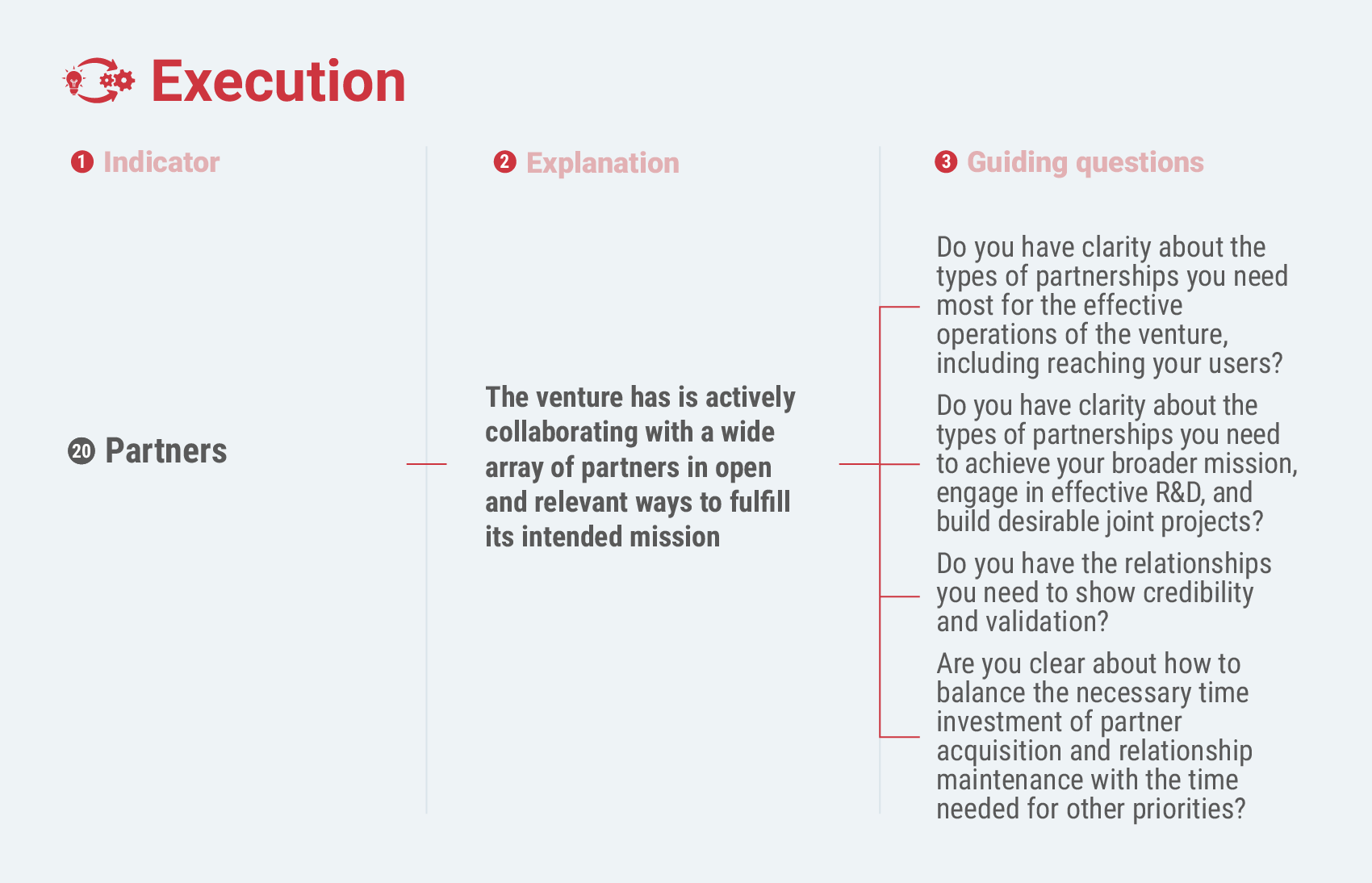
Using the Framework as an Assessment
The SVF can also be used as an assessment tool, whereby a venture is scored for its systemic impact potential on three levels:
- Criteria: For each criteria, a score between 0 to 5 is given, with 5 being the best possible practice to achieve the objective of each category, and 0 being no improvement beyond the status quo of a strictly commercial for-profit-at-all-costs enterprise. Commentary can be included to provide clear reasoning and methods for improvement
- Pillar: Scores are aggregated per pillar in order to understand how a venture is performing in each area and to provide some comparison.
- Holistically: Finally, scores are aggregated as a whole in order to provide an overall comparison to other ventures.
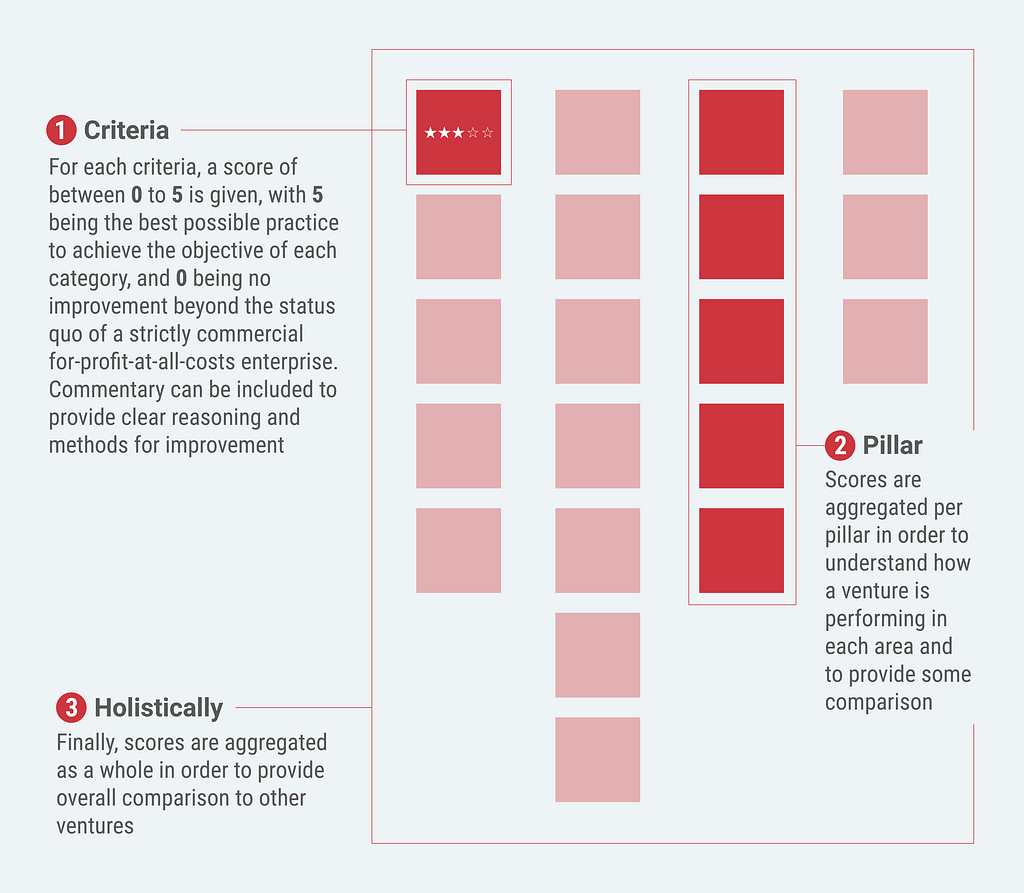
It is extremely difficult to achieve a perfect score of 100, as ventures typically need to make trade-offs. For example, even a near-perfect venture will likely have to choose between creating a solution with “radical breakthrough potential” or a more integrated set of solutions that utilize multiple impact pathways.
To adequately assess a venture, a business plan or similar level of robust and transparent information is typically required.
The assessment should ideally be undertaken by an expert who has a nuanced understanding of the system in question, systemic approaches to venturing, and a decent understanding of the market dynamics and established precedent. When we score ventures ourselves, Metabolic Ventures uses an evolving rubric to reduce subjectivity. But anyone can effectively use the assessment to score their own venture as they design it, or use it as a way to compare ventures with each other. Just keep in mind that without a deeper understanding of the system or sector, scores can become quite subjective.
The scope of the assessment can also be narrowed for certain use-cases. For example, when assessing ideas or concepts before a team or governance method is established, the first two sections (“Problem” and “Solution”) can be used by themselves without the subsequent two sections.
Your Input & Further Reading
If you are in the impact venture ecosystem and supporting the path of impact entrepreneurs, feel free to reach out to see if we can collaborate.
If you are an entrepreneur aimed at creating systemic change, we encourage you to give the framework a spin. If you have time, we would also love to hear any feedback you may have, such as:
- What created a new insight for you?
- Where and how did you improve your venture?
- Which questions did you get stuck on?
- What were the most valuable external resources you found to help you along?
- What did you feel was missing?
For more information:
- Read our whitepaper on Systemic Venture Building (Nov 2020)
- Read our earlier blog on “14 questions to guide entrepreneurs towards deep and lasting impact” (May 2021)
- Follow Fresh Ventures as it works to build transformative ventures that address key challenges in the food system




